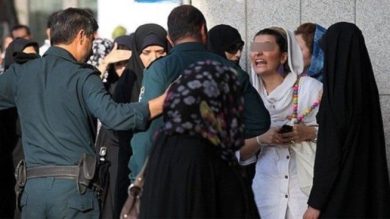For decades, the Islamic Revolutionary Guard Corps (IRGC) has built its power on control—of ideology, territory, the economy, and above all, information. In a regime where television, newspapers, and schools are tightly monitored, the internet represents something dangerous: a space that cannot be fully controlled, a megaphone that carries protest far beyond borders, and a tool that connects Iranians to one another and the world.
For the IRGC, the internet is not just a nuisance. It is a battlefield.
And they are losing ground.
This article explores why the IRGC fears the internet, how it has built a digital police state to combat online dissent, and how Iranian citizens—especially women and youth—are using cyber tools to resist surveillance, censorship, and propaganda. It is a war of code, courage, and connectivity—and the outcome will help define the future of Iran.
1. The IRGC’s Fear: Information Is Power
Authoritarian regimes survive by shaping reality. In Iran, that means controlling:
• What people see
• What they know
• What they say
• And increasingly, what they think
The internet threatens this monopoly.
Why the Internet Frightens the IRGC:
• It spreads unfiltered truth, including videos of crackdowns, prison abuse, and corruption
• It enables decentralized organizing, making protests harder to predict and control
• It provides platforms for women, youth, and minorities who are silenced in state media
• It allows exiled voices to reach millions inside Iran
• It reveals the regime’s fear, incompetence, and brutality to the world
In short: the internet undermines the IRGC’s ideological control—and opens space for resistance.
2. The Rise of Iran’s Cyber Police State
To counter digital threats, the IRGC has built a powerful, multi-layered cyber security and surveillance apparatus.
A. The Cyber Command
• Officially established in the 2000s, expanded rapidly after 2009 Green Movement
• Coordinates with IRGC Intelligence, Basij cyber units, and Ministry of Intelligence
• Monitors all major domestic platforms, including mobile apps and internet service providers
B. National Information Network (NIN)
• A closed, government-controlled intranet that replicates the global internet inside Iran
• Allows censorship, surveillance, and speed throttling
• Promoted as a “secure” system, but used to isolate Iranians from global content
C. Cyber Army (“Gerdab”)
• A digital arm of the IRGC that:
• Hacks opposition sites
• Leaks private information of dissidents
• Runs smear campaigns and disinformation
• Develops spyware and phishing apps
Together, these institutions form the digital fortress of the IRGC’s repression.
3. Censorship as a Weapon
Censorship in Iran is widespread, aggressive, and deeply technical.
Platforms Blocked:
• Facebook, Twitter, YouTube (since 2009)
• Telegram, Signal, WhatsApp frequently throttled or blocked
• News sites like BBC Persian, Voice of America, IranWire
• LGBTQ+ content, women’s rights resources, and secular blogs
Methods of Control:
• DNS filtering
• Deep packet inspection
• Throttling bandwidth during protests
• SMS blackouts
• Mobile internet shutdowns by region
The IRGC also pressures domestic platforms to comply with surveillance demands—making apps like Soroush and Baleh dangerous for users.
4. Surveillance and the Panopticon State
Censorship is only half the strategy. The IRGC also monitors every digital step Iranians take.
How They Spy:
• Telecoms owned or controlled by IRGC-linked entities (e.g., MobinNet)
• Mandatory SIM registration tied to national IDs
• Location tracking via cell towers and apps
• AI-powered facial recognition in public spaces and metro stations
• Phishing campaigns targeting email, Telegram, Signal, and Instagram
Targets of Surveillance:
• Protest organizers
• Feminist activists
• Journalists and students
• Ethnic and religious minorities
• Diaspora-connected users
Even those not politically active face risk: surveillance is so pervasive that self-censorship becomes the norm.
5. Punishing Dissent Online
Speaking freely online in Iran can carry heavy consequences.
Documented Reprisals:
• Arrests for social media posts criticizing hijab laws or the government
• Torture and forced confessions of “cyber criminals”
• Long prison sentences for sharing protest footage
• Sentencing of women influencers for posting unveiled selfies
• Interrogations based on private group chats and forwarded messages
The IRGC treats “cyber crimes” as national security offenses. In some cases, simply reposting content critical of the regime can be punished as “collusion against the state.”
6. Cyberattacks on Activists Abroad
The IRGC’s cyber war doesn’t stop at Iran’s borders.
Known Operations Include:
• Hacking the phones and laptops of exiled journalists and activists
• Launching phishing campaigns disguised as NGO invitations or academic events
• Deploying spyware-laden VPN apps
• Leaking private photos and documents to discredit targets
• Deepfake content targeting prominent figures like Masih Alinejad
These tactics aim to silence diaspora voices, undermine movements like #WomanLifeFreedom, and erode trust in activist networks.
7. Disinformation and Digital Propaganda
In parallel with repression, the IRGC floods the internet with propaganda and lies.
Channels of Disinformation:
• IRGC-affiliated news sites: Tasnim News, Fars News
• Telegram channels and Instagram pages masquerading as “independent” Persian-language outlets
• Bot armies that hijack hashtags, harass activists, or spread conspiracy theories
• Fake accounts on Twitter and Clubhouse that pose as feminists, reformists, or students to gather intelligence
Their goal is to blur truth, sow confusion, and isolate real voices.
8. Resistance: How Iranians Fight Back Online
Despite the IRGC’s digital dragnet, Iranians have become digital warriors—adapting faster than the state.
Tools of Resistance:
• VPNs and circumvention tools: Millions use Psiphon, Lantern, Tor, and other apps to bypass censorship
• Encrypted messaging apps: Signal, Telegram (secret chats), and WhatsApp are used with caution
• Crowdsourced networks: Protest footage is shared with journalists abroad via private channels
• Digital literacy: Online communities teach each other cybersecurity basics and app hygiene
Youth in particular have developed a culture of resistance where online defiance is both political and personal.
9. Women and the Digital Frontline
Iranian women have used the internet to shatter the regime’s control over their bodies and narratives.
Examples:
• #MyStealthyFreedom: Campaign by Masih Alinejad encouraging women to post unveiled photos
• #WhiteWednesdays: Coordinated hijab defiance actions shared online
• Testimonies from prison: Smuggled voice notes, texts, and images reveal sexual violence in custody
• Instagram activism: Fitness instructors, artists, and influencers challenge gender apartheid
The IRGC has responded with bans, arrests, and harassment—but women continue to lead the charge.
10. What the Regime Can’t Control
Despite years of censorship and surveillance, the IRGC has failed to fully conquer the internet.
Why the Internet Wins:
• It evolves faster than repression tools
• It decentralizes protest and amplifies collective action
• It connects inside voices to outside platforms
• It turns victims into reporters and footage into evidence
Each time the regime kills a protester, the internet carries their name around the world. Each act of censorship reveals the fear of freedom.
11. The Role of the International Community
What Tech Companies Must Do:
• Protect Iranian users from surveillance and phishing
• Expand access to circumvention tools
• Refuse to host IRGC disinformation and propaganda
What Governments Can Do:
• Sanction IRGC cyber units and front companies
• Support funding for digital rights organizations and secure communications
• Provide asylum and protection for targeted activists
What Civil Society Can Do:
• Educate the diaspora on cybersecurity
• Amplify verified Iranian voices
• Support platforms that document digital repression
Conclusion: The Digital Intifada
The IRGC was built to crush enemies with tanks and guns. But its most powerful enemy today is not a foreign army—it’s a generation of wired, defiant, fearless Iranians who use the internet to fight back.
Join Our Newsletter!
Stay informed with the latest updates, news, and ways to take action in the fight for justice and global security. Sign up now to get updates delivered straight to your inbox!





